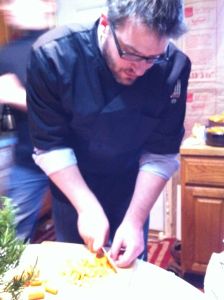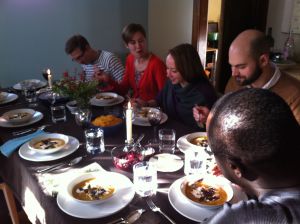When I list my favorite things about Texas, I always start with foods and drinks: Blue Bell Ice Cream, Tex-Mex, Kolaches, Dr. Pepper, and Shiner Bock. Texas has the great distinction of being home to many very distinct and delicious culinary cultures. The obvious ones, Mexican food and Texas BBQ, produce the glory known as brisket tacos. But the lesser known distinct cultures are those from Germany and Eastern Europe. Texas once was the destination for many immigrants from Germany and Czechoslovakia, and in the broad scape of Texas, these immigrants settled in very distinct and geographically separate communities (some so isolated they still speak their native languages) bringing with them their culinary gifts. The Germans brewed their beer creating for Texans the amber-brown delight of Shiner Bock, which is brewed in the small German community of Shiner, Texas, and the Czech’s baked their bread and made their sausages and gave us the kolache (I’m constantly stunned by the number of people who have never heard of nor tried a jalapeno and cheese kolache).
For my family, Christmas meals are a wonderful sampling of Texas’ diverse delights. My family starts on Christmas Eve by treating ourselves to the best tamales I have ever had, made in a little East Dallas shop, as well as a sundry of other delightful Tex-Mex dishes, all served buffet-style in the comfort of our home with some extended family joining us. I am generally so utterly stuffed by the time the meal is over I can barely stay awake through our annual watching of “It’s a Wonderful Life.” The next morning, Christmas opens with kolaches and cinnamon rolls, but I must pace myself—the true joy of Christmas is our late lunch at my aunt and uncle’s house.
Every year my family spends Christmas afternoon at the Kolenovsky’s house. My uncle is of Czech descent, and he and my aunt make an excellent culinary combo. They put on a feast of feasts, spending weeks gathering recipes and preparing for the Christmas celebration. The group is not large, but we quite literally feel like attendees to a king’s feast as the food is examined and the paper crowns and poppers are arranged upon the table. The dishes are an array of Czech soups, smoked ribs and meats so tender they melt in your mouth, unbelievable dressings and stuffings ranging from classic breaded ones to raspberry jalapeno sauces, vegetarian dishes for my sister and father, rolls upon rolls with the prescience to know that I will eat four (well earning my “muffin man” moniker given to me by my aunt), and another Texas staple: pecan pie and ice cream for dessert. They also choose delightful wines and drinks to go with the meal, and never forget to allow for my family’s addiction to Dr. Pepper. All of the tastes overwhelm me—even the thought of the meal will leave my mouth watering.
At the end of every feast, we generally find ourselves in a dazed comatose as my aunt and uncle read us something full of wit and heart. Sometimes these readings make our bellies roll in laughter and sometimes they make us weep, like the time my uncle read us Rudyard Kipling’s poem about a dog dying just two months after we had lost our dog. These moments are as close as I have been to truly coming home. We spend decades of our lives looking for a place we know with our hearts is home, and on Christmas day, the day marking earth and heaven being brought together for all eternity, my family gathers around for a feast, draws near to our true home in this communion, and eats from the best dishes the land God blessed with His own hand can offer.

